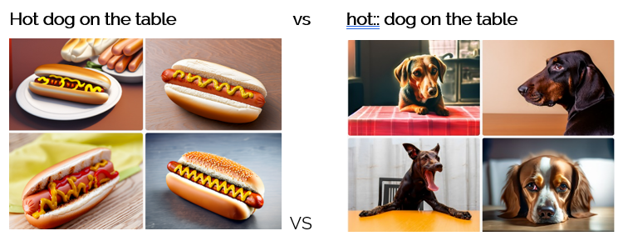We have been exploring Artificial Intelligence (AI) image generators – how they work, what they do, and if we can see a potential use of them in our work. AI content tools are currently a subject of discussion, and it is important to understand their functionality to make informed decisions about their usage.
AI generators create images by extracting patterns from existing platforms like Flickr and generating new pictures that match these patterns. It’s pretty helpful to get to know a primary search term – so you can instruct the AI to find a ‘hot dog’ (a warm canine), rather than a ‘hot dog’ (a sausage)! These tools can replicate various art and photography styles, emulating the techniques of different famous artists, camera equipment, and schools. However, it will not be highly successful recreating the style of your company’s graphic designer, unless AI is trained on those particular types of images.

Pic 1. Images generated in Adobe Firefly
When learning prompts, tags in image libraries can serve as valuable indicators for refining search terms. ChatGPT can assist in formulating appropriate search terms and tailoring prompts to different AI generators. Why don’t let AI talk to AI?
We conducted research on some of the leading AI tools
- Midjourney produces high-quality images, but due to its skyrocketing popularity even testing it requires a subscription. Even though it generates impressive images, it’s based on a social model where everyone in your chatroom can see and use your results.

Pic 2. An image of Midjourny user interface.
- Adobe Firefly, available through Adobe Creative Cloud, does an impressive job with a user-friendly interface. It features a Photoshop plugin named ‘generative fill’ for image modifications. Currently, it’s only a testing tool and not for commercial use. It occasionally produces ‘peculiar’ images with odd shadings and unrealistic elements. It also struggles with depictions of people – especially faces and hands. We can see how generated images could serve as a solid foundation for artists to build upon. It can also be an effective tool for refining minor details in existing images without advanced graphic design knowledge.

Pic 3. An Image generated in Adobe Firefly.
- We did not test DALL-E 2 due to the lack of a free trial, but the quality of online results doesn’t seem to surpass those from Midjourney or DreamStudio.
- Runway offers a free trial for testing. Like other tools, it also faces challenges with rendering human faces and hands. Unlike Midjourney, Runway provides exclusive access to generated images.

Pic 4. Images generated in Runway.
- DreamStudio offers a free trial and exclusive access to generated images. Additionally, it saves your images in the image library, so you can get back to them anytime without downloading them onto your hard drive. The quality of generated images is very impressive, like Midjourney, but with exclusive access to your library.

Pic 5. An image generated in DreamStudio – the first attempt.
Overall, we see DreamStudio as our leading contender because of a user-friendly dashboard, high-quality images including people’s images and its private content library.
A word of summary
AI text-to-image generators are not a magic bullet at the moment, but more an exciting research area. When it comes to commercial use, we still view them primarily as a foundation for the further work of skilled graphic designers. We recognise their potential as communication tools that could cut down a lot of back and forth about how things might look. As the saying goes, “A picture can be worth a thousand words.”
Results generated by AI include an element of randomisation. The AI searches through numerous images and compiles them into one output. This randomness can sometimes make it challenging to precisely achieve the envisaged result and to consistently produce similar outcomes. To achieve more targeted results, many AI generators allow the upload of a reference image. When combined with a prompt, this approach may yield more focused outcomes. We find the future potential of training an AI based on your own image dataset to be truly interesting and potentially useful in terms of branding.
AI-generated images raise questions about who owns the copyright or intellectual property rights to those images. In New Zealand, as in many places, copyright typically belongs to the creator of an original work. However, if the AI-generated images are truly a result of AI algorithms with minimal human input, determining ownership could become complex. Because it combines the creative work of many individuals, there is a huge grey space around what is acceptable. We’re interested in this. What do you think?
